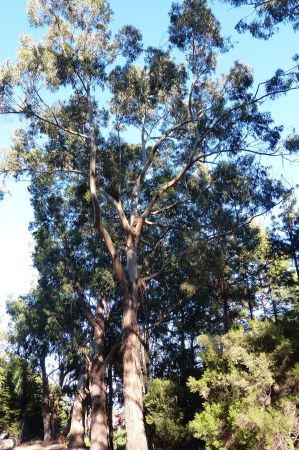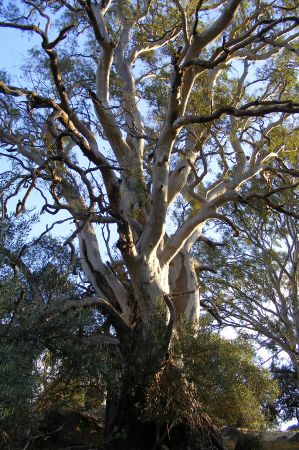The eucalyptus tree is also spreading in the Mediterranean
- Written by Portal Editor
Preservation and protection of nature are important issues on the agenda of many people today. Unfortunately, however, the protection of animals or plants is often misunderstood, namely when the species or genus does not actually belong in a region or can even have a significantly negative impact on the region and thus contribute to the extinction of other species.
Surely you too are familiar with plenty of examples, be it wood pests imported in pallets from China, which have no natural enemies, cute raccoons from the United States or rheas suddenly strutting in large groups across the fields of northern Europe. The eucalyptus is also a representative of such plants newly introduced by humans, which then cause major problems in the new settlement regions.
 The approximately 800 species of eucalyptus originally come from the continent of Australia, including Tasmania and the eastern half of Indonesia. These trees are so widespread here that they account for around 70% of the total tree population. Nowhere else in the world is there an equally dominant species in the tree population. And this is already conditioned by one of the basic properties of the plant. Due to its roots penetrating deep into the soil and the large amounts of water that the tree needs, it literally dries out the soil down to a great depth. This means that the habitat for other plants is lost, and native animals are not aware of the possible uses of the eucalyptus anyway.
The approximately 800 species of eucalyptus originally come from the continent of Australia, including Tasmania and the eastern half of Indonesia. These trees are so widespread here that they account for around 70% of the total tree population. Nowhere else in the world is there an equally dominant species in the tree population. And this is already conditioned by one of the basic properties of the plant. Due to its roots penetrating deep into the soil and the large amounts of water that the tree needs, it literally dries out the soil down to a great depth. This means that the habitat for other plants is lost, and native animals are not aware of the possible uses of the eucalyptus anyway.
Misunderstood protection of plants and animals
 Of course, the eucalyptus is a very interesting tree for the timber industry, as the fast-growing wood is suitable for a wide range of industrial applications. Large-scale plantations for timber production have therefore been set up in southern Europe and South Africa. However, other properties of the eucalyptus also cause major problems here, because due to the wood ingredients in the form of combustible oils, the tree actually increases the risk of forest fires, one can even say that the eucalyptus even benefits from forest fires. Its rhizomes and seeds survive even the strongest fire and can sprout again quickly after the fire. Long before other plants have recovered. Experiments have shown that the seed pods need the great heat of the fire in order to be able to burst open at all. The forest fire not only helps to eliminate parasites, but especially with reproduction and the associated spread. In biology, this process is called pyrophilia.
Of course, the eucalyptus is a very interesting tree for the timber industry, as the fast-growing wood is suitable for a wide range of industrial applications. Large-scale plantations for timber production have therefore been set up in southern Europe and South Africa. However, other properties of the eucalyptus also cause major problems here, because due to the wood ingredients in the form of combustible oils, the tree actually increases the risk of forest fires, one can even say that the eucalyptus even benefits from forest fires. Its rhizomes and seeds survive even the strongest fire and can sprout again quickly after the fire. Long before other plants have recovered. Experiments have shown that the seed pods need the great heat of the fire in order to be able to burst open at all. The forest fire not only helps to eliminate parasites, but especially with reproduction and the associated spread. In biology, this process is called pyrophilia.
Eucalyptus in wood production for industry
 Another quirk of eucalyptus trees is the continuous shedding of large branches from time to time. The branches fall right next to the trunks, giving the fire excellent opportunities to reach the tree itself. Observations in nature have clearly proven that this fact alone has a very strong negative impact on the native fauna, resulting in severe soil erosion. Only the eucalyptus survives, but ensures that the diversity and plants and animals have no chance of surviving. The eucalypts form very special storage roots, called lignotubers, which can quickly sprout again despite the complete destruction of the above-ground plant. Today, based on these findings, eucalyptus trees are being removed from individual regions on a large scale just to normalize the water balance again, which is how projects like "Working for Water" came about.
Another quirk of eucalyptus trees is the continuous shedding of large branches from time to time. The branches fall right next to the trunks, giving the fire excellent opportunities to reach the tree itself. Observations in nature have clearly proven that this fact alone has a very strong negative impact on the native fauna, resulting in severe soil erosion. Only the eucalyptus survives, but ensures that the diversity and plants and animals have no chance of surviving. The eucalypts form very special storage roots, called lignotubers, which can quickly sprout again despite the complete destruction of the above-ground plant. Today, based on these findings, eucalyptus trees are being removed from individual regions on a large scale just to normalize the water balance again, which is how projects like "Working for Water" came about.
Specialty Lignotuber - the memory roots
 As already mentioned, eucalyptus wood is a very fast-growing wood, which is why the wood industry in particular has "earned" the spread of the trees. The number of species alone determines the very different appearances as an evergreen shrub or tree. The giant eucalyptus (eucalyptus regnans) can reach a height of 100 meters and a trunk circumference of 20 meters. Due to the extensive use in the timber industry, the eucalyptus can be found in almost all subtropical regions of the world today. In addition to wood production, the focus is on the extraction of essential oils.
As already mentioned, eucalyptus wood is a very fast-growing wood, which is why the wood industry in particular has "earned" the spread of the trees. The number of species alone determines the very different appearances as an evergreen shrub or tree. The giant eucalyptus (eucalyptus regnans) can reach a height of 100 meters and a trunk circumference of 20 meters. Due to the extensive use in the timber industry, the eucalyptus can be found in almost all subtropical regions of the world today. In addition to wood production, the focus is on the extraction of essential oils.
Essential oils of eucalyptus - cineol
 The essential oil is obtained from the leaves and branches of the eucalyptus tree by means of steam distillation. The many types alone cause the different compositions of the oils obtained from them. About 50 types are used professionally today to extract oils, whose biochemical composition and the associated mode of action could not be more different. Being able to distinguish the species here is a subject in itself. The European Pharmacopoeia lists the different types that may be used to extract eucalyptus oil. The medically most well-known tree is probably the blue eucalyptus. The most important component in the oil is probably the cineole, which can also be harmful in too high a dose. So caution is always advised, even if you think you know essential oils. Consumer advocates are therefore not unjustified in demanding precise information on the ingredients of the oils, which are particularly popular for inhaling in the case of colds.
The essential oil is obtained from the leaves and branches of the eucalyptus tree by means of steam distillation. The many types alone cause the different compositions of the oils obtained from them. About 50 types are used professionally today to extract oils, whose biochemical composition and the associated mode of action could not be more different. Being able to distinguish the species here is a subject in itself. The European Pharmacopoeia lists the different types that may be used to extract eucalyptus oil. The medically most well-known tree is probably the blue eucalyptus. The most important component in the oil is probably the cineole, which can also be harmful in too high a dose. So caution is always advised, even if you think you know essential oils. Consumer advocates are therefore not unjustified in demanding precise information on the ingredients of the oils, which are particularly popular for inhaling in the case of colds.
Another area of application shows how toxic eucalyptus oils can be, because eucalyptus oil is used in bee care to combat mites.
Please read as well:
